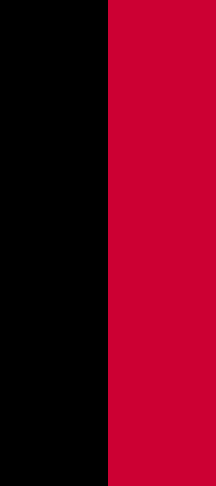 Image by Jens Pattke, 14 December 2012
Image by Jens Pattke, 14 December 2012Land colours attributed to the Territorial Association of the Sathmar Swabians

Last modified: 2020-07-26 by pete loeser
Keywords: territorial association of the sathmar swabians | landsmannschaft der sathmarer schwaben e.v. | sathmar swabians | sathmarer schwaben | vertriebene | refugees | coat of arms: per fess (eagle: black) |
Links: FOTW homepage |
search |
disclaimer and copyright |
write us |
mirrors
 Image by Jens Pattke, 14 December 2012
Image by Jens Pattke, 14 December 2012
Land colours attributed to the Territorial Association of the Sathmar Swabians
Jens Pattke reported in the German vexillology mailing list about the flag of one of the Landsmannschaften (territorial or country associations) of Vertriebene (refugees from former German territories or formerly German-inhabited regions in Eastern Europe). He explained that the Landsmannschaften of the Sathmar Swabians, the Banat Swabians and the Danube Swabians share the same coat-of-arms, which shows the German Imperial Eagle, a blue wavy fess representing the river Danube and the fortress of Temeschburg (Temesvar / Timisoara) with six towers representing the six main Danube-Swabian districts:
With the end of World War II, the Sathmarer Swabians were asked if they want to live in their traditional areas of settlement, the present Romanian districts of Satu Mare and Bihar (also parts of Oradea, Salaj and Maramure).
While Banat Swabians and Danube Swabians were expelled to Germany and Austria, the Swabians remained in their homeland. They showed their willingness to cooperate. The Sathmarer Swabians at first took the flags of the Territorial Association of the Banat Swabians (Landsmannschaft der Banater Schwaben e.V.) and Territorial Association of the Danube Swabians (Landsmannschaft der Donauschwaben e.V.)
Jens Pattke, 14 December 2012
 Image by Jens Pattke, 14 December 2012
Image by Jens Pattke, 14 December 2012
Speculative Flag of the Territorial Association of the Sathmar Swabians
The use of a flag is not known, but an analysis of the photos in Google shows a black-red bicolore. This is most likely the flag of Territorial Association of Sathmar Swabians. This flag is identical to the flag of Wurtemberg, the
original home of the Swabians in the Black Forest. All meetings of this territorial organization (Bundestreffen) were held in Wurtemberg. Therefore, these colors symbolize the two homes of the displaced persons and their ancestors. The traditional Black Forest garb also showed the black and red. Some cultural associations of the German minority in Romania have adopted unique flag.
Sources: Based on colours displayed at the Bundestreffen der Sathmarer Schwaben 2002 and Bundestreffen der Sathmarer Schwaben 2009.
Jens Pattke, 14 December 2012
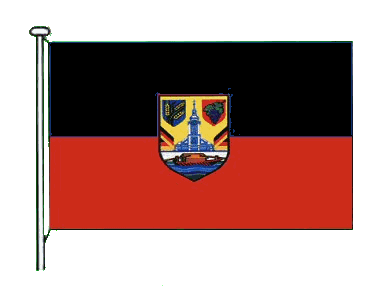
Image by Pete Loeser, 14 December 2012
Speculative Flag of the Territorial Association of the Sathmar Swabians
In 1989 and 1990, there was a mass emigration of Romanian Germans to Germany.
Pete Loeser, 14 December 2012
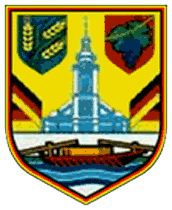 Images by Jens Pattke
Images by Jens Pattke
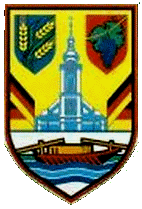 Variant image by Pete Loeser
Variant image by Pete Loeser
In Germany, the Sathmarer Swabians are considered a subset of the Danube Swabians. Because few Sathmarer Swabian people emigrated to Germany and Austria, this population was represented in the organizations Bund der Vertriebenen (BdV, Germany) and Verband der Volksdeutschen Landsmannschaften ÷sterreichs (VL÷, Austria) by the Territorial Association of the Danube Swabians. Officially, the Territorial Association of the Sathmar Swabians (Landsmannschaft der Sathmarer Schwaben e.V. of has no coat-of-arms, but this one has seen common use. It originated in the 1990s as an emblem with the German flag and the coat-of-arms of the historic districts of Bihor and Satu Mare. The crest also symbolizes the Danube and the Cathedral of Satu Mare. Please see Bund der Vertriebenen for other similar coat-of-arms.
Jens Pattke, 9 December 2012
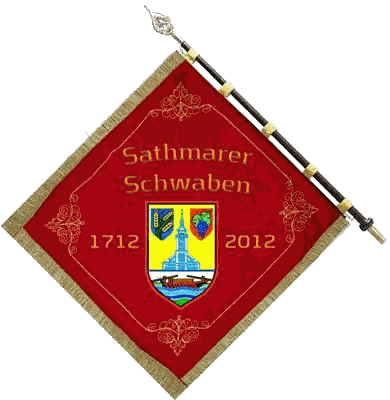
Image from "Democratic Forum of the German District of Satu Mare" (Demokratisches Forum der Deutschen), 14 December 2012
The anniversary celebration of the settlement of the Sathmar Swabians took place on May 18-20, 2012 in Satu Mare. The 300-year old settlement of the Satu Mare experienced the first wave of settlement of the Sathmars in 1712.
Sources: Demokratisches Forum der Deutschen (in German) and image from here.
Pete Loeser, 9 December 2012